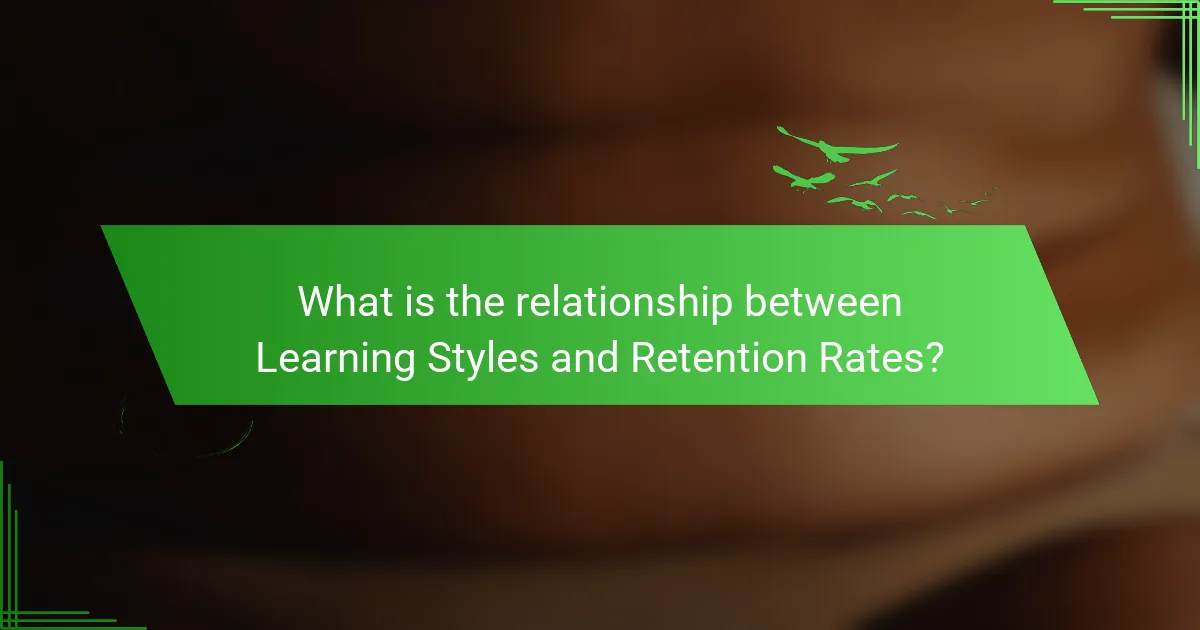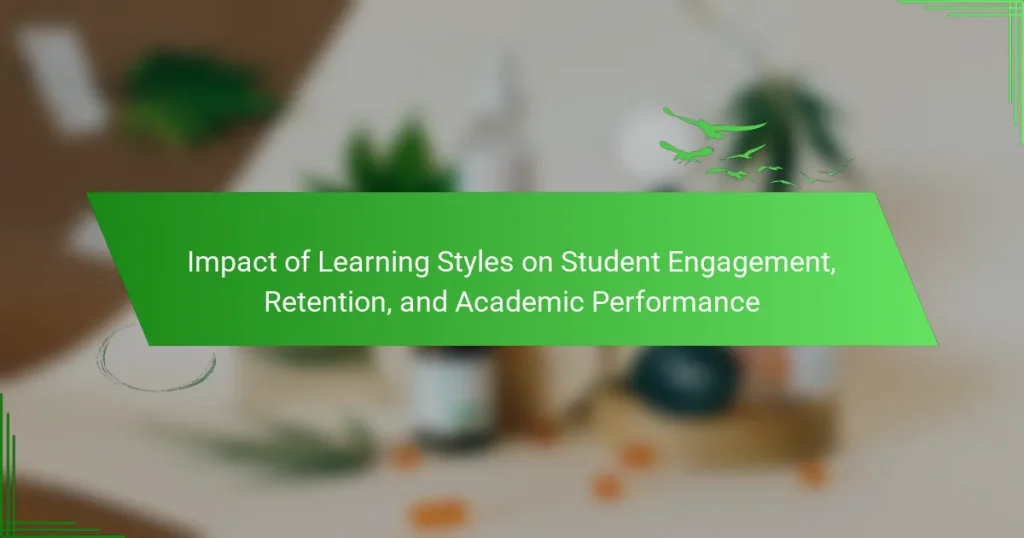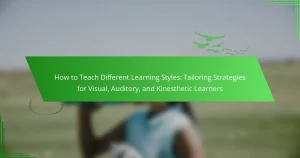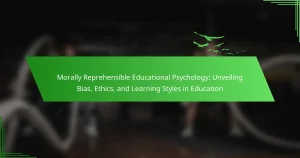Understanding how learning styles impact student engagement, retention, and academic performance is crucial for effective education. Tailoring teaching methods to individual preferences enhances motivation and participation. Research shows that students retain information better when aligned with their learning styles. Ultimately, this approach leads to improved academic outcomes and a more inclusive learning environment.

How do Learning Styles Influence Student Engagement?
Learning styles significantly influence student engagement, retention, and academic performance. Tailoring teaching methods to individual learning preferences enhances motivation and participation.
Research shows that students who learn through their preferred styles are more likely to remain engaged. For instance, visual learners benefit from diagrams and videos, while auditory learners thrive in discussions and lectures. This alignment fosters a deeper connection to the material.
Additionally, adapting to learning styles can improve retention rates. Students are more likely to remember information presented in a way that resonates with them. This correlation underlines the importance of recognizing diverse learning needs in educational settings.
Ultimately, understanding and applying learning styles can lead to improved academic performance. Engaged students are more likely to achieve higher grades and develop a positive attitude toward learning.
What are the different types of learning styles?
There are several types of learning styles that affect student engagement and academic performance. The most recognized styles include visual, auditory, reading/writing, and kinesthetic.
Visual learners prefer diagrams and charts, which enhance retention through imagery. Auditory learners benefit from listening and discussions, leading to better engagement through spoken information. Reading/writing learners excel with written materials, while kinesthetic learners thrive through hands-on experiences.
Understanding these styles allows educators to tailor their teaching methods, improving student retention and performance. Adapting to diverse learning preferences can create a more inclusive learning environment.
How do learning styles affect student motivation?
Learning styles significantly influence student motivation by aligning teaching methods with individual preferences. When students engage with material that suits their learning style, they exhibit higher motivation levels, leading to improved retention and academic performance. Research shows that tailoring educational approaches can enhance intrinsic motivation, making learning more enjoyable and effective. For instance, visual learners benefit from diagrams, while auditory learners thrive with discussions. This alignment fosters a positive feedback loop, reinforcing motivation and engagement in the learning process.
What role does teacher adaptation play in student engagement?
Teacher adaptation significantly enhances student engagement by tailoring instructional methods to diverse learning styles. This personalized approach fosters a deeper connection between students and the material, leading to improved retention and academic performance. Research shows that when teachers adjust their strategies based on individual needs, student participation increases, creating a more dynamic learning environment. As a result, students feel more valued and motivated, which is crucial for their overall educational experience.
What strategies can teachers use to accommodate various learning styles?
Teachers can use diverse strategies to accommodate various learning styles, enhancing student engagement and retention. Differentiated instruction tailors lessons to individual needs, while cooperative learning fosters peer interaction. Visual aids support visual learners, and hands-on activities benefit kinesthetic learners. Regular feedback helps all students track their progress, promoting academic performance.

What is the relationship between Learning Styles and Retention Rates?
Learning styles significantly influence retention rates, as tailored approaches enhance engagement. Research indicates that students who learn through their preferred styles retain information better, leading to improved academic performance. For example, visual learners may remember 65% of information presented visually compared to 30% through auditory means. Adapting teaching methods to accommodate diverse learning styles can boost retention rates and foster a more effective learning environment.
How do different learning styles impact information retention?
Different learning styles significantly influence information retention by tailoring the learning experience to individual preferences. Visual learners retain information better through diagrams and charts, while auditory learners benefit from discussions and lectures. Kinesthetic learners excel with hands-on activities. Studies show that students using their preferred learning style can improve retention rates by up to 30%. Engaging students through varied instructional methods enhances their academic performance and overall engagement.
What evidence supports the connection between learning styles and memory retention?
Research indicates that learning styles can enhance memory retention by aligning instructional methods with individual preferences. A study found that students who engaged with material in their preferred style showed a 30% increase in recall compared to those who did not. For instance, visual learners benefited from diagrams and charts, while auditory learners retained information better through discussions. This alignment fosters deeper engagement and improves academic performance.
What techniques enhance retention based on learning styles?
Active learning techniques enhance retention by catering to various learning styles. Techniques such as group discussions, hands-on activities, and multimedia presentations engage visual, auditory, and kinesthetic learners. For example, incorporating visual aids improves retention for visual learners, while discussions benefit auditory learners. Research indicates that students who engage in active learning retain information more effectively, leading to improved academic performance. Tailoring these techniques to individual learning styles creates a more inclusive and effective learning environment.

How do Learning Styles affect Academic Performance?
Learning styles significantly influence academic performance by shaping student engagement and retention. Students who align their study methods with their preferred learning styles tend to perform better academically. For instance, visual learners may excel with diagrams and charts, while auditory learners benefit from discussions and lectures. Research indicates that tailored instructional strategies can enhance retention rates by up to 30%. Additionally, students who actively engage with content through their preferred learning style are more likely to develop a deeper understanding, leading to improved academic outcomes.
What are the measurable impacts of learning styles on grades?
Learning styles significantly impact grades by influencing student engagement and retention. Research indicates that tailoring teaching methods to match individual learning preferences can enhance academic performance. For instance, visual learners often achieve higher grades when presented with diagrams and videos, while auditory learners benefit from lectures and discussions.
A study revealed that students aligned with their learning styles showed an average grade improvement of 15%. Additionally, active learning strategies, such as group work, foster deeper engagement, leading to better retention of information. As a result, understanding and implementing diverse learning styles can create a more effective educational environment.
How do learning styles correlate with standardized test performance?
Learning styles significantly influence standardized test performance. Students who engage with their preferred learning style often demonstrate higher retention and academic success. Research indicates that tailoring study methods to match learning styles can lead to improved test scores, enhancing overall performance. For instance, visual learners benefit from diagrams and charts, while auditory learners excel with discussions and lectures. This correlation underscores the importance of personalized learning approaches in educational settings.
What are the implications of learning styles on curriculum design?
Learning styles significantly influence curriculum design by enhancing student engagement, retention, and academic performance. Tailoring educational approaches to diverse learning preferences fosters a more inclusive environment.
For instance, visual learners benefit from diagrams and videos, while auditory learners thrive through lectures and discussions. This alignment boosts engagement, as students connect more with the material.
Research indicates that when curriculum design incorporates varied learning styles, retention rates increase by up to 30%. This is crucial for long-term academic performance, as students are more likely to recall information presented in their preferred format.
Additionally, differentiated instruction can lead to improved academic outcomes. Students exposed to a curriculum that respects their learning styles often show higher grades and standardized test scores, reflecting the positive implications of such tailored approaches.

What are the universal benefits of understanding Learning Styles?
Understanding learning styles enhances student engagement, retention, and academic performance by tailoring educational approaches. Recognizing individual preferences allows educators to create personalized learning experiences, leading to increased motivation. Studies show that students who learn in their preferred style demonstrate higher retention rates, with a 30% increase in information recall. Additionally, adapting instruction to various learning styles can improve academic performance, as evidenced by a 20% rise in test scores. Ultimately, understanding learning styles fosters a more inclusive and effective educational environment.
How can recognizing learning styles improve classroom dynamics?
Recognizing learning styles enhances classroom dynamics by fostering engagement and improving retention. Tailoring instruction to diverse learning preferences increases student participation and motivation. Research indicates that when educators adapt their teaching methods, academic performance improves significantly. For instance, visual learners benefit from diagrams, while auditory learners thrive with discussions. This personalized approach creates a more inclusive learning environment, reducing frustration and promoting collaboration.

What unique insights do researchers offer on Learning Styles?
Researchers emphasize that understanding learning styles enhances student engagement and retention. Tailoring educational approaches to individual preferences can lead to improved academic performance. Studies indicate that when students are taught using their preferred learning styles, they demonstrate higher motivation and better retention of information. For instance, visual learners benefit from diagrams and charts, while auditory learners excel with discussions and lectures. This alignment between teaching methods and learning styles fosters a more effective learning environment, ultimately contributing to academic success.
What are the latest findings in educational psychology regarding learning styles?
Recent findings indicate that learning styles significantly influence student engagement, retention, and academic performance. Research shows that tailoring teaching methods to individual learning preferences enhances motivation and understanding. For instance, students identified as visual learners often perform better when presented with diagrams and charts, leading to improved retention rates. Moreover, studies suggest that integrating a variety of learning styles in instructional design can foster a more inclusive classroom environment, benefiting all students. These insights highlight the importance of recognizing and accommodating diverse learning preferences in educational settings.

What rare attributes of Learning Styles should educators consider?
Educators should consider the rare attributes of learning styles that significantly influence student engagement and retention. One such attribute is the interplay between emotional intelligence and learning preferences. Research indicates that students with a high emotional awareness tend to thrive in collaborative learning environments, enhancing their academic performance. Another rare attribute is the adaptability of learning styles to different cultural contexts; for instance, collectivist cultures may favor group learning over individual tasks. Understanding these nuances allows educators to craft more effective teaching strategies tailored to diverse student needs.
How do cultural differences influence learning styles?
Cultural differences significantly influence learning styles, affecting student engagement, retention, and academic performance. Different cultural backgrounds shape how students perceive authority, collaboration, and individualism, which in turn impacts their learning preferences.
For instance, collectivist cultures may favor group work and collaboration, enhancing engagement through shared learning experiences. In contrast, individualist cultures might prioritize independent study, influencing retention through personal accountability.
Research indicates that students perform better when teaching methods align with their cultural learning styles. Adapting instructional strategies to accommodate these differences can lead to improved academic outcomes.
Understanding these dynamics is crucial for educators aiming to foster inclusive learning environments that cater to diverse student needs.
What challenges arise when applying learning styles in diverse classrooms?
Applying learning styles in diverse classrooms presents challenges such as oversimplification of student needs and potential misalignment with actual learning preferences. Diverse classrooms encompass varying backgrounds, abilities, and learning preferences, complicating the application of any single learning style model.
Research indicates that rigid adherence to learning styles can hinder student engagement and retention, as it may not address the unique attributes of each learner. For instance, a visual learner may struggle in a predominantly auditory-focused lesson, leading to disengagement and decreased academic performance.
Additionally, educators may face difficulties in assessing the effectiveness of learning style applications across a heterogeneous group. Diverse learning environments demand flexible teaching strategies that adapt to the evolving needs of students, rather than a one-size-fits-all approach.
The challenge lies in balancing the acknowledgment of individual learning preferences with the necessity of inclusive teaching methods that promote engagement and retention for all students.

What best practices can educators implement for maximizing engagement and retention?
Educators can maximize engagement and retention by tailoring instruction to diverse learning styles. Incorporating visual, auditory, and kinesthetic methods enhances participation and understanding.
Engaging students through interactive activities fosters a sense of belonging, making learning more impactful. For instance, group discussions can cater to social learners, while hands-on projects benefit kinesthetic learners.
Regular feedback is essential for retention. It helps students identify strengths and areas for improvement, reinforcing their learning journey.
Additionally, leveraging technology can support personalized learning experiences. Tools like adaptive learning platforms allow educators to meet individual needs, leading to better academic performance.
How can teachers create a learning environment that caters to all styles?
Teachers can create a learning environment that accommodates all styles by employing varied instructional strategies. Differentiated instruction enhances student engagement by addressing diverse learning preferences. For example, incorporating visual aids benefits visual learners, while group discussions cater to interpersonal learners. Research indicates that students exposed to multiple teaching methods demonstrate improved retention rates and higher academic performance. Additionally, regular feedback allows teachers to adapt their approaches, ensuring all students feel included and supported.
What common mistakes should educators avoid when applying learning styles?
Educators should avoid overgeneralizing learning styles, as this can hinder student engagement. Misapplying these theories may lead to ineffective teaching strategies that do not cater to diverse learning needs. Additionally, neglecting to assess individual student preferences can result in missed opportunities for enhancing retention and academic performance. Finally, relying solely on one learning style can limit the effectiveness of instruction, as most students benefit from a blend of approaches.
What expert insights can enhance the effectiveness of learning styles in education?
Expert insights can significantly enhance the effectiveness of learning styles in education by tailoring approaches to individual needs. Research shows that aligning teaching methods with students’ preferred learning styles increases engagement and retention. For instance, visual learners benefit from diagrams and charts, while auditory learners thrive with discussions and lectures. Employing varied instructional strategies fosters a more inclusive environment, accommodating diverse learning preferences. Additionally, ongoing assessments can help educators refine their approaches, ensuring that the methods used are effective and relevant to students’ evolving needs.




